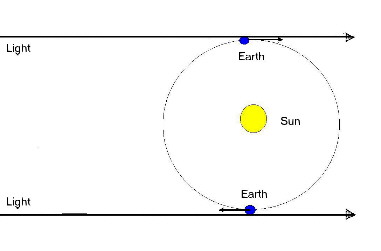of
Dipl.Math. Ulrich Meyer
, St.Goar, Feb. 2001
![]()
![]()
This is a translation from German language
and therefore it may be not perfect.
In physics before Einstein, the classical mechanics,
speeds of moving systems were always calculated additive.
In addition an example:
If a person moves in a
moving train, the speed of the person in relation to the rails of the railway
embankment is calculated by the speed of the person to the train plus the speed of the train
to the railway embankment.
During the circulation of the earth around the sun
the earth is touched also by light beams, which have occasionally the same direction as the earth.
The earth and these light beams of an asterisk moves in the same
direction. A half year later these light beams come to meet exactly the earth movement.
According to the principle of the addition
of speeds someone would have to assume, the speed of the light beams
would be smaller in the first case of the same-directed movement than six
months later, when earth and light beams come against themselves ( see
image ).
 All measurements of the light however always
showed a constant value for the speed of light of approximately
300,000 km/sec². This seemed to contradict the experiences with speeds
on earth totally. Albert Einstein solved this contradiction 1905 with
his theory of relativity, which means among other things that by systems moving against to
other systems the times and lengths of one system measured from the other are always different.
They behave relatively to every system. This relativity of
lengths and times is not to be understood with our five senses.
All measurements of the light however always
showed a constant value for the speed of light of approximately
300,000 km/sec². This seemed to contradict the experiences with speeds
on earth totally. Albert Einstein solved this contradiction 1905 with
his theory of relativity, which means among other things that by systems moving against to
other systems the times and lengths of one system measured from the other are always different.
They behave relatively to every system. This relativity of
lengths and times is not to be understood with our five senses.
You imagine now, you can look into a moving train.
A 1 meters wooden board in the train would be measured from outside less
than 1 m and in the train exactly 1 m. This looks like magics. But it occurs only if the train
would move approximately with speed of light, i.e. the classical mechanics after
Newton is not removed by the theory of relativity. She is considered furthermore as true, if
you has to do only with relatively small speeds. With approach
to the speed of light you must consult the special theory of
relativity for the physical view, which concerns itself with uniform movements.
In general theory of relativity Einstein makes statements to masses,
gravitation and further phenomena of the universe as, for example, the curvature
of the space. One of its most important knowledge is contained in the formula
(energy is masses multiplied by the squared speed of
light). It means the equivalence of masses and energy.
Today the statements of the theory of relativity are undisputed and proven
in the reality by many examples.
Examples:
a) Elementary particles, also masses, were produced from pure
energy radiation.
b) µ-Mesonen appear during the cosmic radiation in
approximately 30 km height. From lab tests we know their life span
with 2·10 -6 seconds.
From their point of origin they could move with the maximal speed, the speed of light, only
600 m until they were disaggregated. They come
however down to earth's surface. Since they move almost with speed of
light, their life span is extended for an observer on the earth. From this
fact, you can conclude that a spaceman, who moves in space with
approximately speed of light ages slowly.
Further information ( in german ) :
Astronomia
Abenteuer-Forschung
(For the contents of the linked sides we give no guarantee, therefore always the respective offerer or operator of the sides is responsible.)
![]()
--------------------------------------------------------------------------------------------------------------------------------------
March 2006